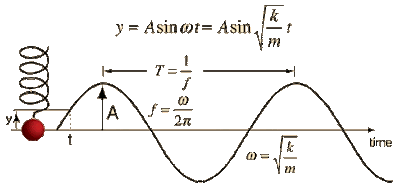A body is said to move or vibrate with simple harmonic motion (SHM), if it satisfies following conditions:
1) Its acceleration is always directed towards the center as point of reference or mean position, and
2) Its acceleration is proportional to the distance from that point.
The following terms are commonly used in simple harmonic motion:
1. Amplitude (A)
It is the maximum displacement of a body from its mean position. The amplitude is always equal to the radius of the circle.
2) Periodic Time (T)
It is the time taken for one complete revolution of the particle.
Mathematically,
Periodic time, T = ( 2*pi ) / w sec
3) Frequency (f)
It is the number of cycles per second and it is the reciprocal of time period (t)
Mathematically,
Frequency, f = 1/T = w / (2* pie)
Note: In SI, the unit of frequency is hertz (Hz) which is equal to one cycle per second.
1) Its acceleration is always directed towards the center as point of reference or mean position, and
2) Its acceleration is proportional to the distance from that point.
The following terms are commonly used in simple harmonic motion:
1. Amplitude (A)
It is the maximum displacement of a body from its mean position. The amplitude is always equal to the radius of the circle.
2) Periodic Time (T)
It is the time taken for one complete revolution of the particle.
Mathematically,
Periodic time, T = ( 2*pi ) / w sec
3) Frequency (f)
It is the number of cycles per second and it is the reciprocal of time period (t)
Mathematically,
Frequency, f = 1/T = w / (2* pie)
Note: In SI, the unit of frequency is hertz (Hz) which is equal to one cycle per second.


No comments:
Post a Comment